Crew 45 – Assigned 754th Squadron – October 1943
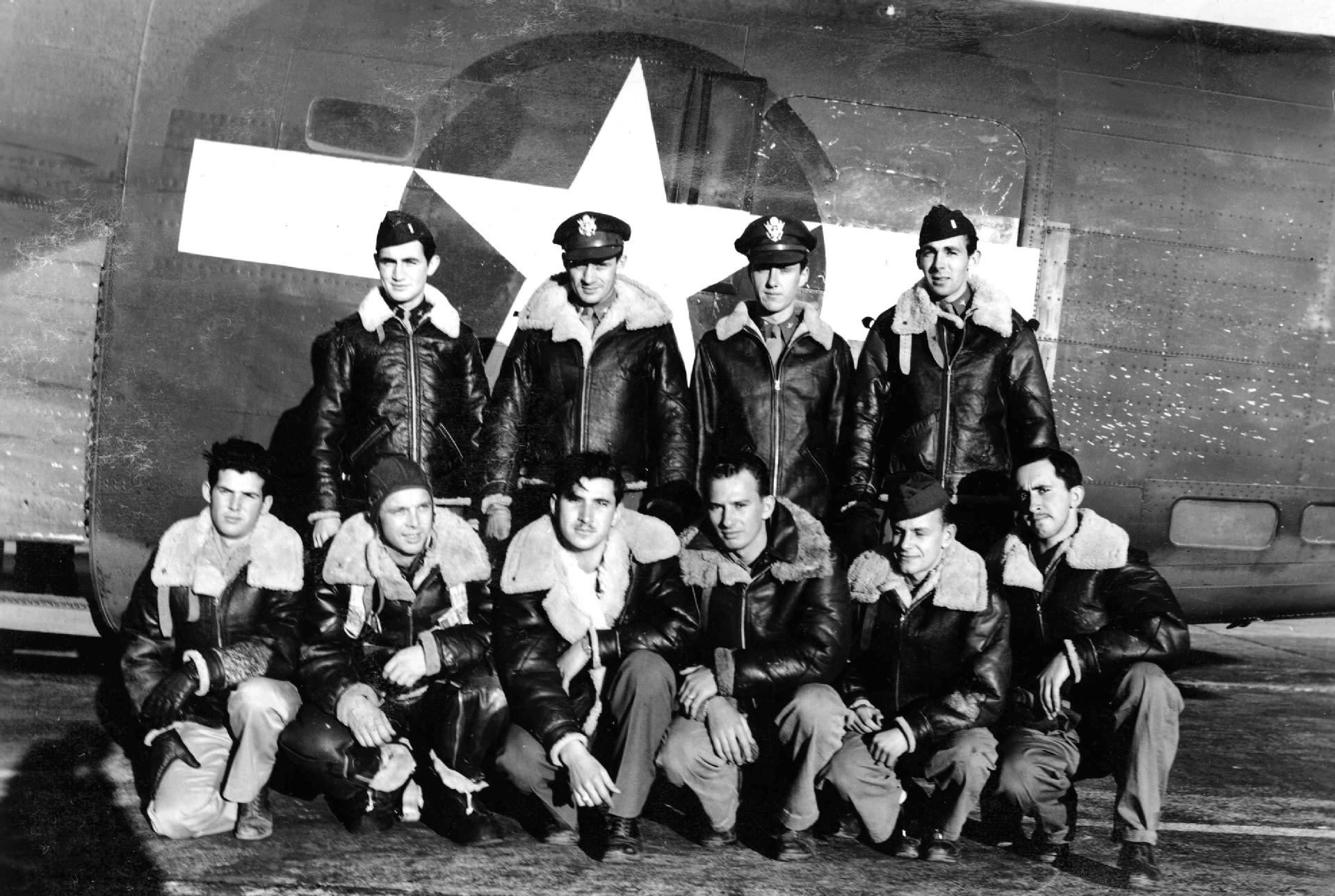
Collided with B-17 during assembly May 23, 1944 – Accident Report 44-5-24-510
| Rank | Name | Serial # | Crew Position | Date | Status | Comments |
|---|---|---|---|---|---|---|
| 1Lt | Kenneth C Barton | 0663831 | Pilot | 23-May-44 | KIA | Gratiot County, MI |
| 1Lt | Ernest T Herndon | 0681415 | Co-pilot | 06-Mar-44 | POW | Shot down w/Crew 48 |
| 2Lt | Charles G Noblitt | 0811874 | Navigator | 23-May-44 | KIA | Bartholomew County, IN |
| 2Lt | Preston W Campbell, Jr | 0747977 | Bombardier | 23-May-44 | KIA | Cambridge American Cemetery |
| S/Sgt | John B Zitnak | 17160455 | Flight Engineer | Aug-44 | CT | Awards - Distinguished Flying Cross |
| S/Sgt | Roy A Torkelson | 19070665 | Radio Operator | 23-May-44 | KIA | Cambridge American Cemetery |
| S/Sgt | Harold R McGlynn | 15076042 | Aerial Gunner, 2/E | 23-May-44 | KIA | Stark County, OH |
| S/Sgt | Maynard T Halsted | 17155618 | Airplane Armorer-Gunner | 23-May-44 | KIA | Cambridge American Cemetery |
| S/Sgt | Richard E Arnold | 15116810 | Aerial Gunner, 2/E | 23-May-44 | KIA | Montgomery County, OH |
| S/Sgt | Carroll J Labbee | 31325501 | Airplane Armorer-Gunner | 23-May-44 | KIA | Hartford County, CT |
Crew 45 was an original crew, which trained at Tonopah, NV and flew with the group to England in January 1944. The photo caption from the 458th records shows that, during training, 2Lt Howard C. Bodine was the co-pilot for the crew, and 2Lt Edward J. Cohen was navigator. At some point prior to overseas movement, Lt Cohen was replaced by Lt Charles Noblitt (Crew 40), and Lt Bodine was replaced by 2Lt Ernest T. Herndon (Crew 40). Herndon and Noblitt are not pictured with this crew, rather they are pictured with their original Crew 40, pilot Harry Pierce. Lt Bodine eventually ended up with the 5AF 90BG Jolly Rogers in the Pacific. Lt Cohen went to the 13AF 5BG 72BS, also in the Pacific Theater. He is listed as Killed In Action on July 12, 1944. Herndon went down on the March 6, 1944 raid to Berlin while flying with Crew 48, pilot Thayer Hopkins. It is believed that Barton flew as either lead or deputy lead on most of his missions, so it is possible that he received no replacement co-pilot, that seat instead being occupied by a command pilot.
Barton’s crew flew on the April 22, 1944 mission to Hamm, Germany [documented in Night of the Intruders, by Ian MacLachlan]. Barton lead the second 458th Bomb Group section and was able to bomb the primary target, the marshalling yards at Hamm, while the first section had poor visibility and proceeded to the secondary target at Koblenz.
On May 23, 1944 the 458th Bomb Group set out for the Luftwaffe Airfield at Bourges, France. Newly assigned co-pilot, 2Lt William J. Fuqua (assigned to 2Lt Robert W. Hansen’s crew) flew with Barton that day. During assembly, the 458th formation encountered a B-17 formation flying at right angles to one another. Due to poor visibility, the two groups of heavy bombers could not avoid each other and the two combat wings flew through one another. A B-17 of the 351st Bomb Group, piloted by 1Lt Peter E. Crowe crashed into the B-24 in which Barton and Crew 45 were flying. Both ships broke up and crashed near Eye, Suffolk. Three crew members of the B-17 managed to parachute to safety, but all of Barton’s crew perished.
Sgt John B. Zitnak, the Crew’s flight engineer, was not on the May 23rd mission. He was wounded on April 25, 1944, while flying with this crew. It was on this April mission that the crew was leading the 2nd Bomb Division when they took heavy damage from fighter attacks. Despite this damage, the crew were able to successfully bomb the target. (See DFC citations below). Sgt Zitnak may have been in hospital on May 23rd, thus missing this particular mission. Records note Zitnak completed his combat tour in August 1944. Taking his place as flight engineer on the 23rd was S/Sgt Charles A Leonard, Jr. from New Haven, CT. Nothing in the group records indicate when he was assigned to the 458th, but notes from S/Sgt Robert Morin, gunner on the crew of 2Lt Martin D. Williams, show that he was assigned with them in April 1944 as the flight engineer.
DESCRIPTION OF ACCIDENT [458th BG Report]
From witnesses statements the following narrative is established. The B-24 group was formed at 13,000 feet and flying a course of approximately 252 degrees. The B-17 group was formed at 13,000 feet also and flying a course of 320 degrees. When first sighted by the B-24 formation, the B-17’s were ahead and to the left on the course indicated. They could not change altitude either up or down, or turn either direction fast enough to clear the two formations. The B-17’s continued their course and a collision resulted between one ship from each formation.The visibility was six (6) to eight (8) miles in haze according to one witness, which does not allow much time for maneuvering a large formation under the circumstances described.
DESCRIPTION OF ACCIDENT [351st BG Report]
The Lead Box of which Lt. Crowe was leading the Low Squadron, was in a left hand circle around Splasher #6. As it turned to a northerly heading, one group of B-24’s passed in front on a West heading. These were avoided by crossing behind the B-24’s. A second group of B-24’s approaching from the East failed to turn in time and when it finally became aware of the B-17 groups directly ahead, it attempted a turn to the right in order to parallel the B-17’s. This maneuver began too late and both formations shuffled.It is believe that the leader of the second box of B-24’s could have avoided this condition by turning to the left and crossing behind the B-17 formation. Also, since the B-17’s had just turned away from the sun, the responsibility fell upon the B-24 formation which had its back to the sun.
Recommendations are that B-24’s be assigned different assembly areas, that greater coordination between Division on assembly be achieved, and that the common complaint of B-24’s failing to make sufficient evasive maneuvers be brought to the attention of higher headquarters.
Missions (Lead Crew)
| DATE | TARGET | 458th Msn | Pilot Msn | Cmd Pilot | Serial | RCL | Sqdn | A/C Msn | A/C Name | Comments |
|---|---|---|---|---|---|---|---|---|---|---|
| 21-Mar-44 | WATTEN | 10 | 1 | 42-52335 | R | Z5 | 8 | ADMIRABLE LITTLE CHARACTER | ||
| 24-Mar-44 | ST. DIZIER | 13 | 2 | 41-28709 | I | 7V | 6 | LUCKY STRIKE | ||
| 27-Mar-44 | BIARRITZ | 15 | NTO | 42-52353 | -- | Z5 | -- | UNKNOWN 049 | NO TAKE OFF - INST | |
| 12-Apr-44 | OSCHERSLEBEN | REC | ABT | 41-28682 | I | Z5 | -- | UNKNOWN 003 | ABORT-#4/RECALL | |
| 13-Apr-44 | LECHFELD A/F | 21 | 3 | 41-29305 | N | Z5 | 9 | I'LL BE BACK/HYPOCHONDRIAC | ||
| 19-Apr-44 | PADERBORN A/F | 23 | 4 | 42-52353 | J | Z5 | 18 | UNKNOWN 049 | ||
| 22-Apr-44 | HAMM M/Y | 25 | 5 | HENSON | 42-100366 | B | Z5 | 12 | MIZPAH | LEAD SEC 2 |
| 25-Apr-44 | MANNHEIM A/F | 27 | 6 | ISBELL | 42-100362 | A | Z5 | 8 | SWEET LORRAINE/BOOMERANG | LEAD SEC 1 |
| 27-Apr-44 | BONNIERES | 29 | 7 | WRIGHT | 42-95018 | J | Z5 | 1 | OLD DOC'S YACHT | DEP LEAD SEC 2 |
| 27-Apr-44 | BLAINVILLE-SUR-L'EAU M/Y | 30 | 8 | 42-95018 | J | Z5 | 2 | OLD DOC'S YACHT | ||
| 04-May-44 | BRUNSWICK/WAGGUM | 34 | 9 | 42-110172 | D | Z5 | 4 | UNKNOWN 017 | ||
| 08-May-44 | BRUNSWICK | 37 | ABT | HENSON | 42-110172 | D | Z5 | -- | UNKNOWN 017 | LEAD ABORT - GAS LEAK |
| 10-May-44 | DIEPHOLZ | REC | -- | 42-110172 | D | Z5 | -- | UNKNOWN 017 | RECALL BEFORE EC | |
| 11-May-44 | EPINAL | 39 | 10 | CHAMBERLAIN | 42-110172 | D | Z5 | 5 | UNKNOWN 017 | LEAD SEC 2 |
| 12-May-44 | BOHLEN | 40 | 11 | 42-110172 | D | Z5 | 6 | UNKNOWN 017 | FLEW WITH 467TH | |
| 20-May-44 | RHEIMS A/D | 43 | 12 | HENSON | 42-110172 | D | Z5 | 8 | UNKNOWN 017 | LEAD SEC 2 |
| 23-May-44 | BOURGES | 45 | ACC | 42-110172 | D | Z5 | -- | UNKNOWN 017 | MID AIR COLLISON B-17 |
April 25, 1944 – Division Lead
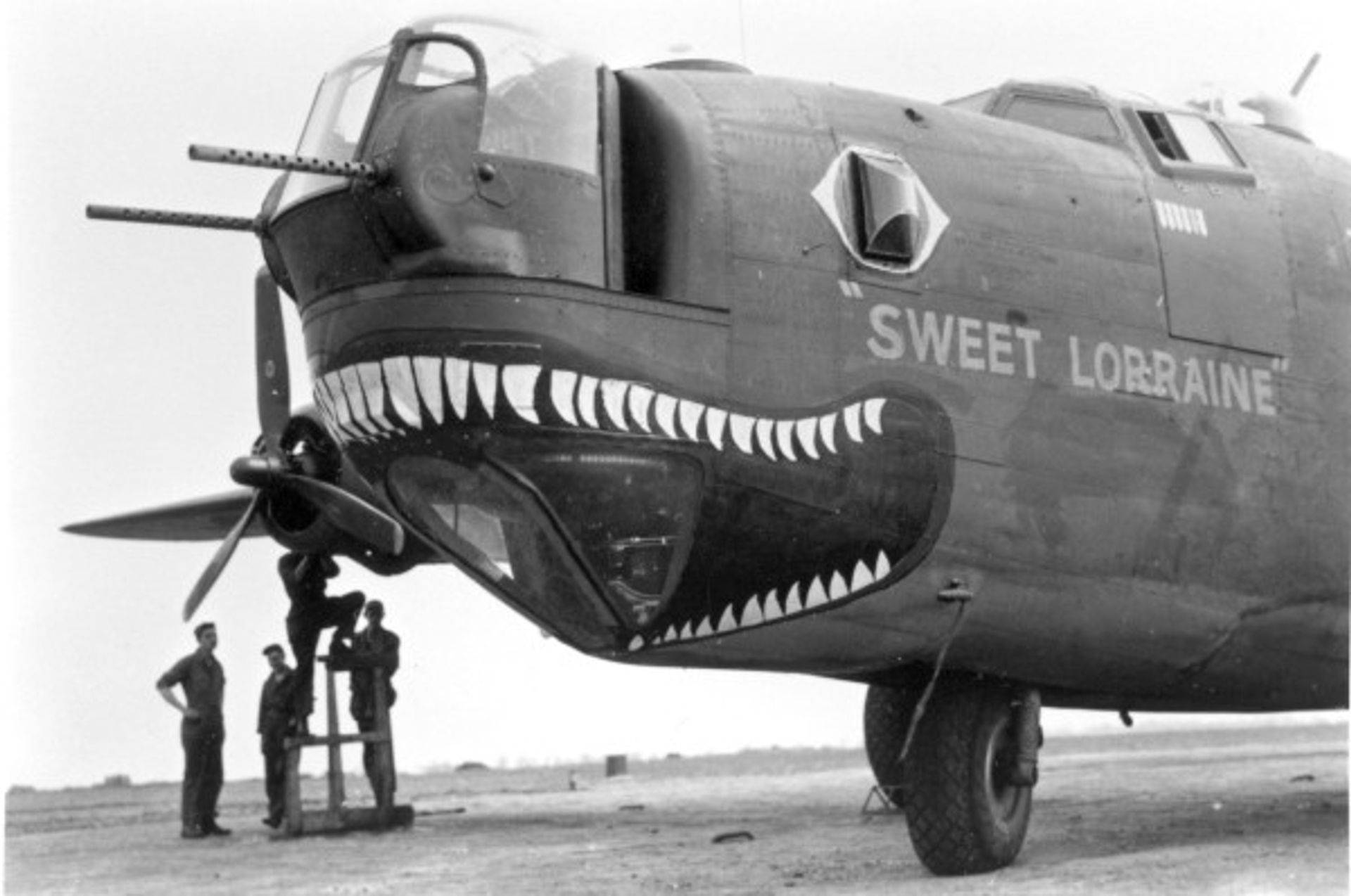
April 25, 1944: Col Isbell was Command Pilot on Barton’s aircraft for the mission to Mannheim, Germany
Distinguished Flying Cross Citations

KENNETH C. BARTON, 0-663831, First Lieutenant, Army Air Forces, United States Army. For extraordinary achievement while serving as a Lead Pilot of a B-24 Division on a bombing mission to Germany, 25 April 1944. Lieutenant Barton’s aircraft sustained severe damage from vicious enemy fighters. The tail and top turrets were shot out, oxygen and hydraulic lines perforated, and the elevator trim tab was shot away making it difficult to maintain control of the aircraft. Lieutenant Barton, with superior flying skill, continued in his position spearheading the entire Eighth Air Force to successfully bomb the primary target with excellent results. Returning to home base, Lieutenant Barton skillfully landed his crippled aircraft without brakes and with partial control. The outstanding leadership and cool courage under fire as demonstrated by Lieutenant Barton on this occasion reflect the highest credit upon himself and the United States Army Air Forces. Entered military service from Michigan.
ELMER M. MOTTERN, 0-724342, Captain, Army Air Forces, United States Army. For extraordinary achievement, while serving as Lead Navigator of a B-24 Division on a bombing mission to Germany, 25 April 1944. Captain Mottern’s aircraft was subjected to aggressive attacks by enemy fighters approximately one hour from the target. Hydraulic lines were broken and oxygen lines ignited by 20mm explosion under the flight deck. Captain Mottern, after successfully extinguishing the fire, succumbed from lack of oxygen, but was revived by the Bombardier and returned to his post to lead the entire Division on a successful bomb run over the primary target. The courage, perseverance, and navigational skill exhibited by Captain Mottern reflect the highest credit upon himself and the United States Army Air Forces. Entered military service from North Carolina.

JOHN (NMI) ZITNAK, 17160455, Staff Sergeant, Army Air Forces, United States Army. For extraordinary achievement while serving as Aerial Engineer of a B-24 aircraft on a bombing mission to Germany, 25 April 1944. Sergeant Zitnak was wounded by an exploding 20mm shell as his aircraft was subjected to aggressive fighter attacks. Sergeant Zitnak made the necessary repairs to damaged oxygen and hydraulic lines and assisted in the manual lowering of the landing gear and flaps as the aircraft landed at base. He then collapsed from his wounds and exertion. The devotion to duty and perseverance, in spite of painful wounds, reflect the highest credit upon himself and the United States Army Air Forces. Entered military service from Missouri.
May 23, 1944 – Accident Report 44-5-24-510
FRANK E. WRIGHT, Captain, AC, 754th Bombardment Squadron (H), 458th Bombardment Group (H) AAF 123 APO 558
Location: 5219-0102 E Time: 0653 Our Course: 252° Their Course: 280-320° Altitude: 13,000 feet
“The 458th Group was flying the high right squadron on the 467th Group’s lead squadron. The accident occurred at 0653. The Wing had assembled and was on course of 252 degrees magnetic when the lead group of B-17’s were noticed approaching from the left at the same altitude of 13,000 feet on a collision course.
The visibility at the time was restricted to an estimated 6 to 8 miles by haze. Clouds formed a 10/10 undercast at approximately 8000 feet. When first discovered approaching in a slight left turn on an estimated course of from 280 degrees to 310 degrees and it was impossible to maneuver our formation in any direction to avoid the impending collision course. An upward or downward maneuver would merely have resulted in entanglement of the two formation’s high or low elements. A right turn would merely have killed all vision by any aircraft in our formation to the approaching B-17’s and would not have taken our formation out of their path.
The oncoming aircraft appeared to be holding steady to their altitude so as a last resort we dived below the aircraft flying directly toward our own. We barely passed under these planes and then pulled up rapidly to avoid the lower planes in the B-17 formation.
At this time, a diagram of the situation would appear thus:
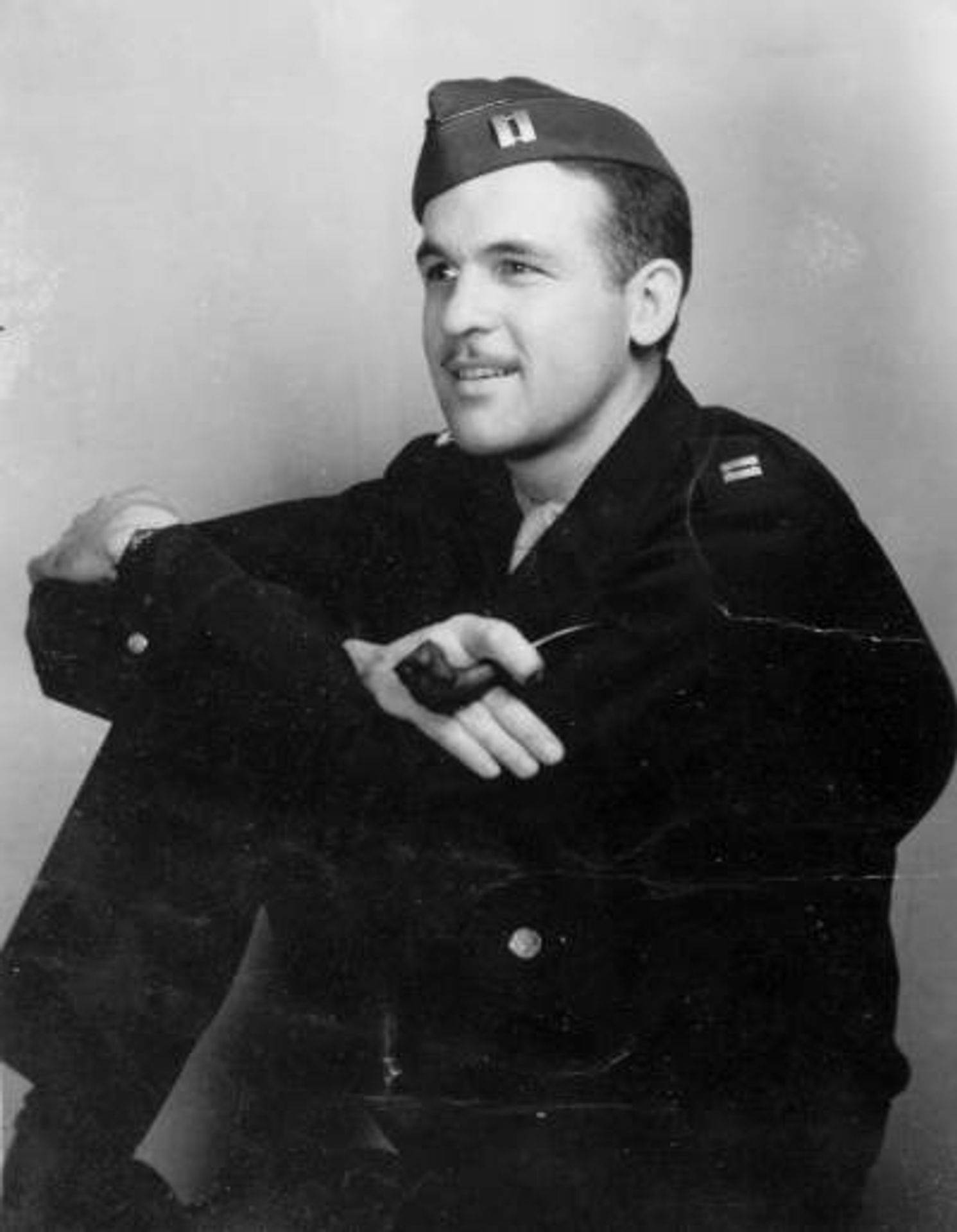

The following moments were consumed by a wild scramble of planes passing through each others formation and the remaining of our original formation.
Looking back to the right I observed the two aircraft which had collided spiraling earthward. The B-24 appeared to be ruptured in the mid-fuselage section. The B-17 had lost a wing and had a hole in the fuselage.
/Signed/
Frank E. Wright
Captain
First Lieutenant ALFRED C. BRAUER, 0-659234, Air Corps, 754th Bombardment Squadron, AAF 123 APO 558 [Crew 43]
We were flying at approximately 13,000 feet when I saw a group of B-17’s come in at our altitude and on a 90 degree course from ours. One B-17 ran into Lt BARTON’s plane at the rear Bomb-bay and tore his plane half in two. At the time I saw the crash, it appeared that the B-17 exploded and tore Lt BARTON’s plane in two at the same time. The tail section of Lt BARTON’s plane tumbled through the air and I saw no one bail out, the fore-section of the plane flipped upside down and tumbled at the time it disappeared from my sight. I had seen no fire and no one leave the ship.
/Signed/
Alfred C. Brauer
1st Lt. AC
First Lieutenant ANTHONY J. DE GENNARO, 0-811406, Air Corps, 754th Bombardment Squadron, AAF 123 APO 558
Position plotted at time of accident was about 8 miles NE of Diss. We were lead ship, Lt BARTON on right wing flying deputy lead. We were flying on course of 250 degrees magnetic when spearhead of group of B-17’s approached in collision course flying on course of approximately 320 degrees or 340 degrees magnetic. Had they stayed at altitude they were at first they could have avoided us but for some reason they dove. One B-17 was avoided by swinging nose up. We missed him by approximately 50 to 75 feet, but he collided with deputy lead ship. B-24 immediately broke in half in vicinity of bulkhead at waist and bomb-bay. The forward part hung in the air momentarily then plunged earthward. No chutes were seen by Crew 41. The B-17, after collision, was thrown upward and turned on its back, then spun through the clouds. It did not come apart, but parts were falling off on way down. No chutes were seen. Time was 0653.
/Signed/
Anthony J. De Gennaro
First Lieutenant CHARLES B. PETERS, 0-1295479, Air Corps, 754th Bombardment Squadron, AAF 123 APO 558 [Crew 53]
“As our formation was heading for the coast, a formation of B-17s approached our formation from an 11 o’clock position and seemed to turn directly into our formation. (I was riding the nose turret of our ship 163, which was flying in #3 position of the lead element of the lead section). As the B-17s turned into our formation, I noticed that our formation broke up. Lt BARTON, who was flying #2 position of the lead element dropped back and down, and a few seconds later a B-17 hit Lt BARTON’s ship at the left waist window. There was a large flash of flame or an explosion and the tail portion of Lt BARTON’s ship was cut off and both parts of the ship dropped down into the clouds. I did not see what happened to the B-17 after it hit the B-24, as it dropped back out of sight.
/Signed/
Charles B. Peters
1st Lt, AC.
Crew 74 – Flew left wing on Barton May 23, 1944
1Lt Allen C. Hilborn – Co-pilot
“We were flying #159 [42-95159] off the left wing of Barton during assembly. The group was northeast of Horsham St. Faith in an area over The Wash. Since I was flying at the time, my eyes were glued to the wing of Barton’s ship, which was about thirty feet ahead and slightly to the right of our ship. I was monitoring the group radio frequency while Curt [Vogel, the pilot] was on the intercom. I heard a lot of radio chatter about a group of B-17’s approaching from nine o’clock. A few moments later Curt yelled, ‘DOWN!’ at which point I dropped the nose sharply while Curt cut the throttles. Still looking at Barton’s ship, I saw a B-17 [42-97325, piloted by Lt. Peter E. Crowe, 351BG] hit their nose section with the right wing. The wing of the B-17 broke off, and flames appeared from the burst fuel tanks. Barton’s ship broke apart at the waist, spilling men and all sorts of material. Another B-17 passed directly over us. When we landed after the mission, we found out how close that B-17 came to hitting us — the antenna wire that ran from the fuselage to the right rudder had been cut neatly in two. This was my worst mission.”
1Lt Samuel D. Scorza – Navigator – Log Entry
“0652 B-17 collided with B-24 B-17 caught fire both ships broken up About 10 men seen bail out No chutes.”
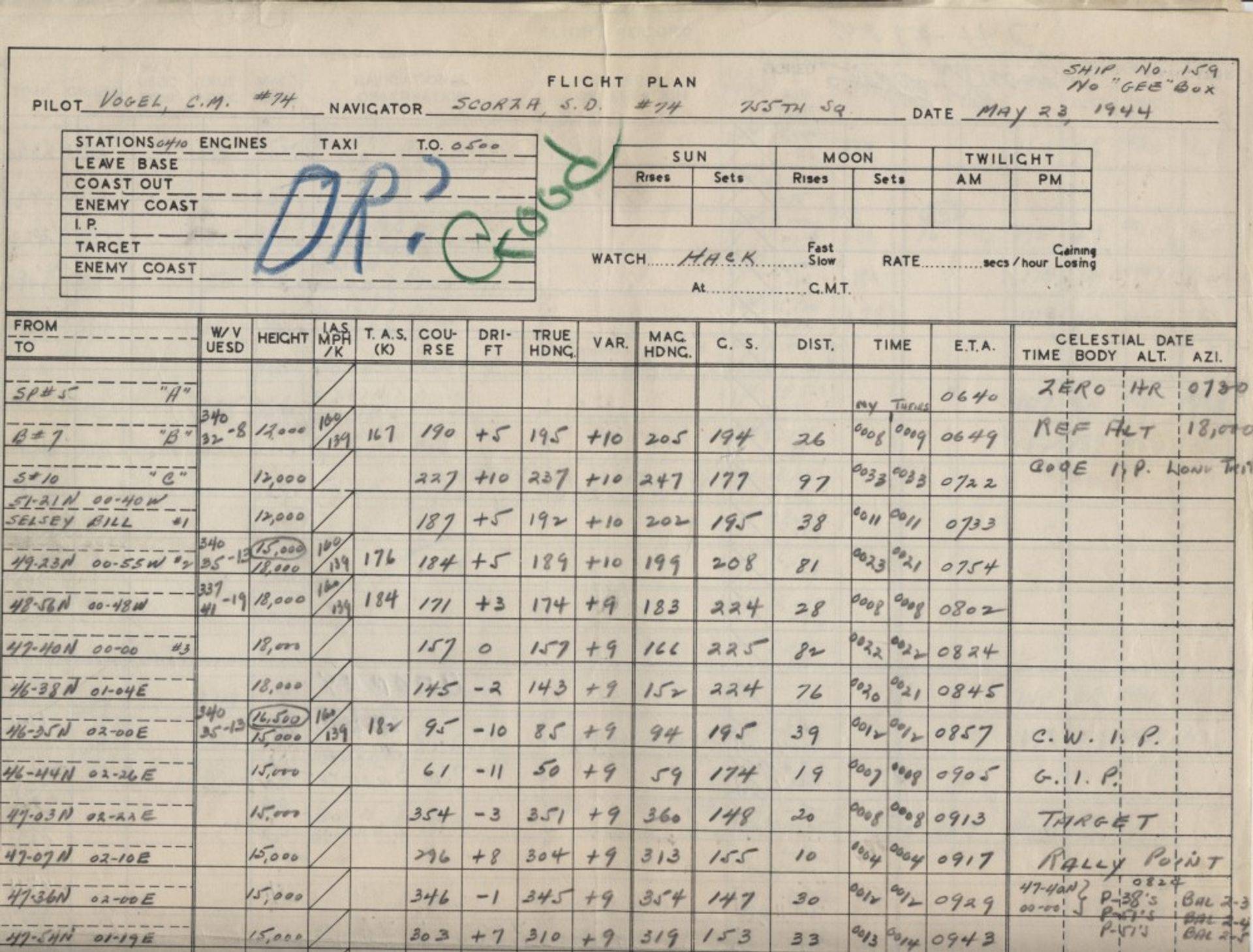
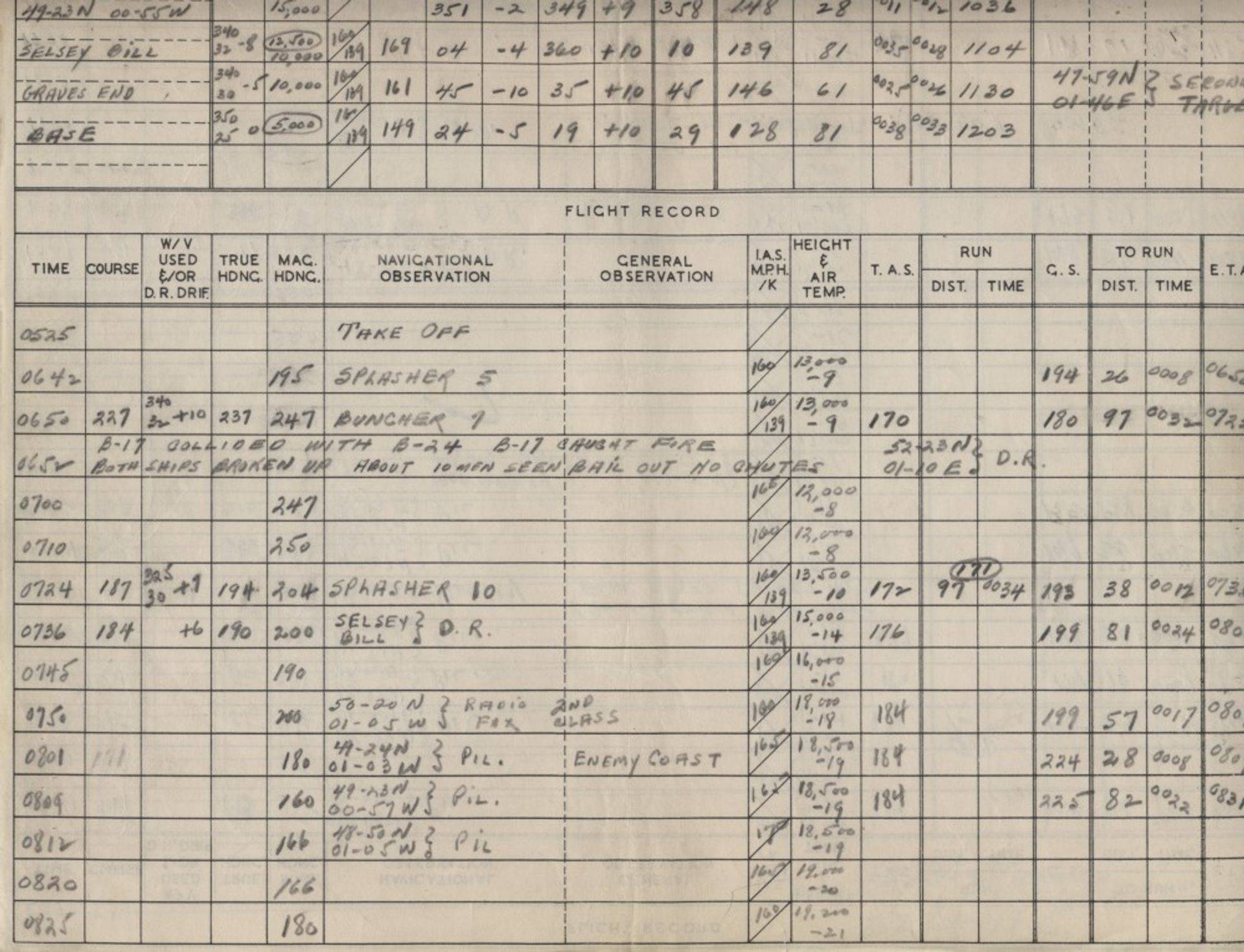
Crash site
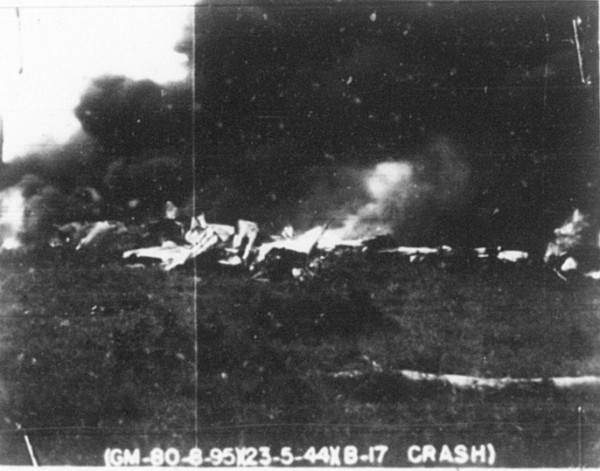
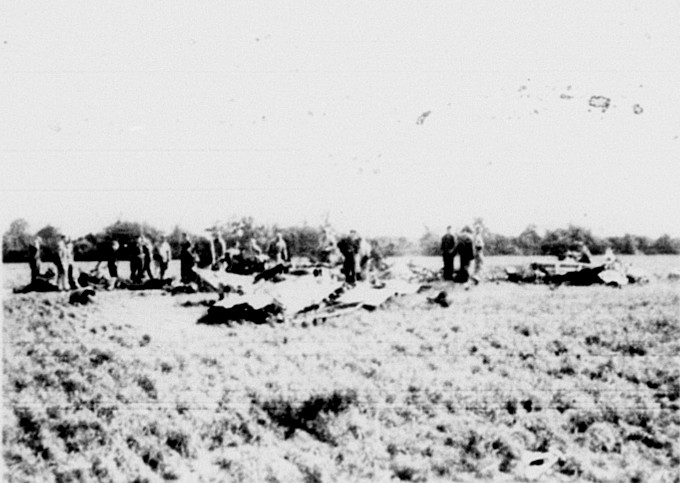
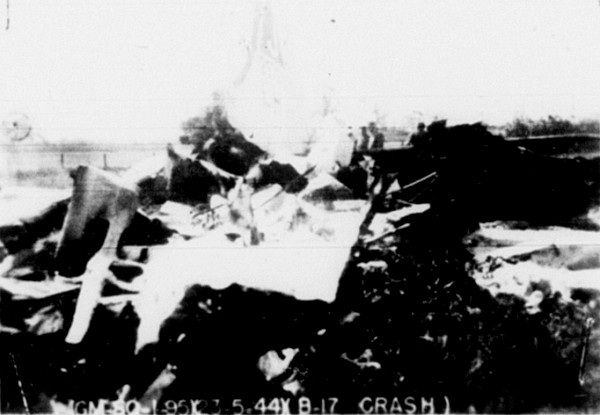
S/Sgt Charles A. Leonard, Jr
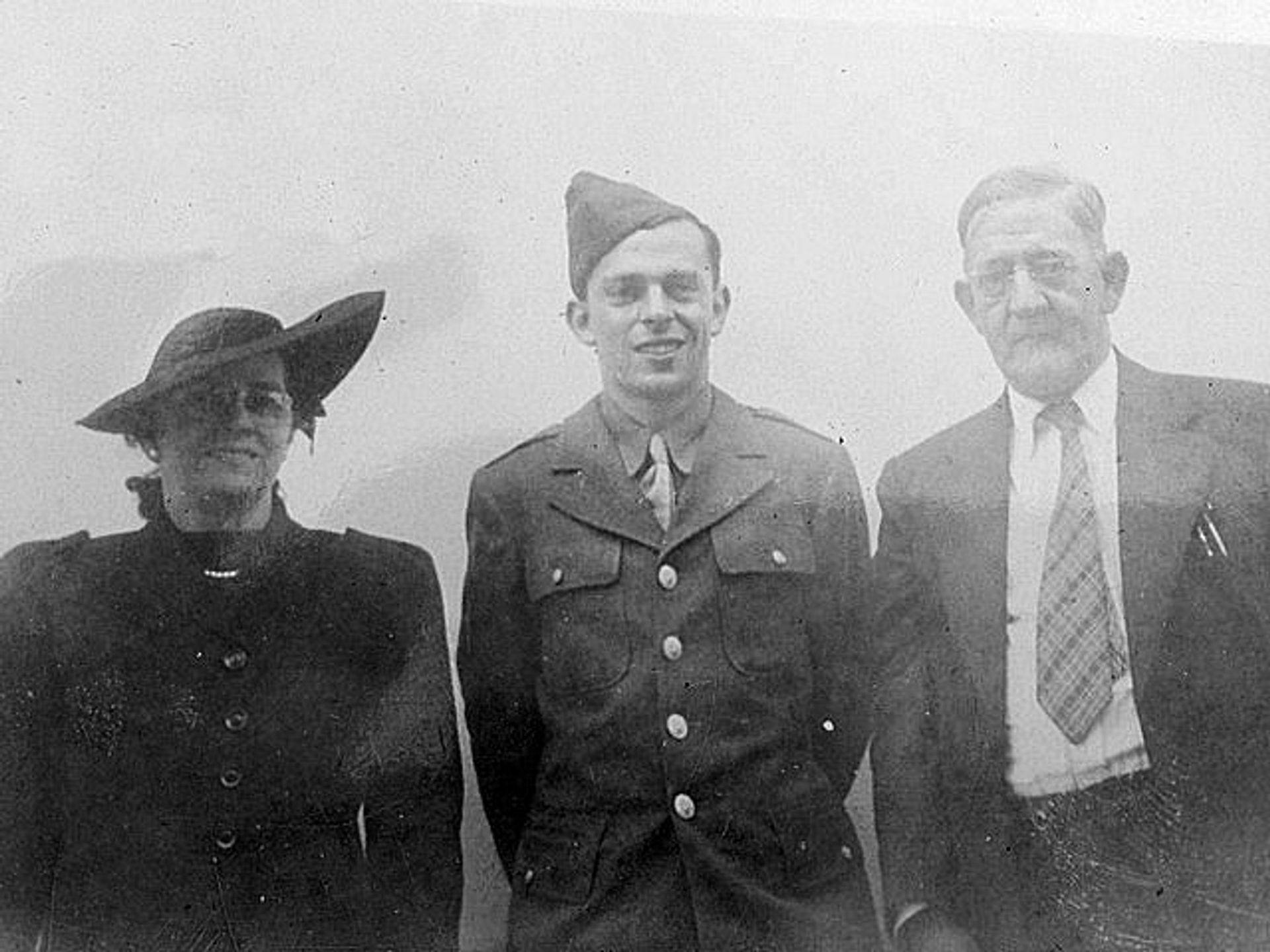
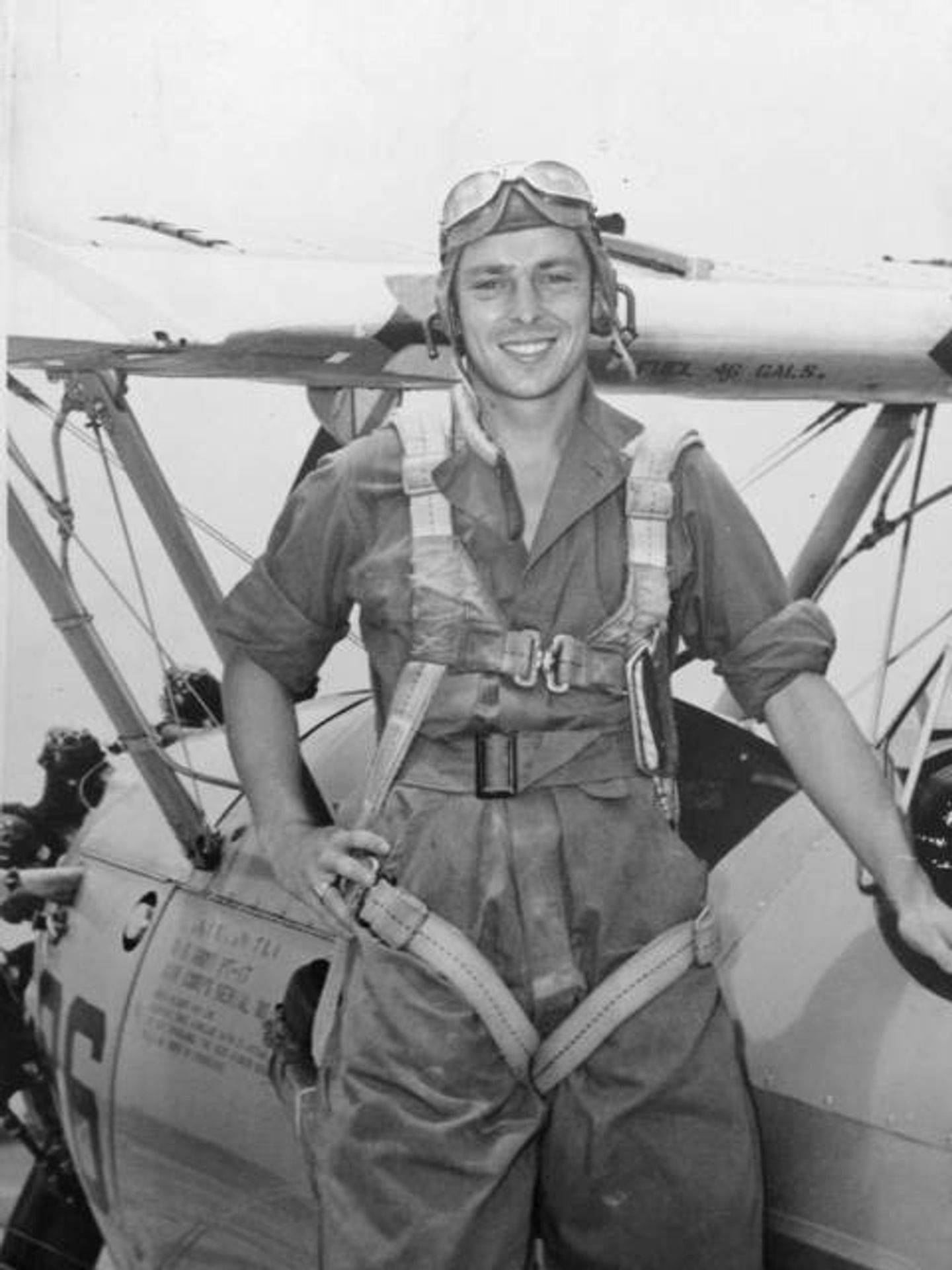
Charles Leonard, shown left, with his parents and at right during flight training, was a fill-in on the May 23, 1944 mission with Barton. Leonard was the flight engineer on 2Lt Martin D. Williams‘ crew, assigned in April 1944. Going by the photo on the right, he may have gone through pilot training before becoming a flight engineer. He is buried in Long Island National Cemetery.
(Courtesy: Sarah Griswold Collins)
